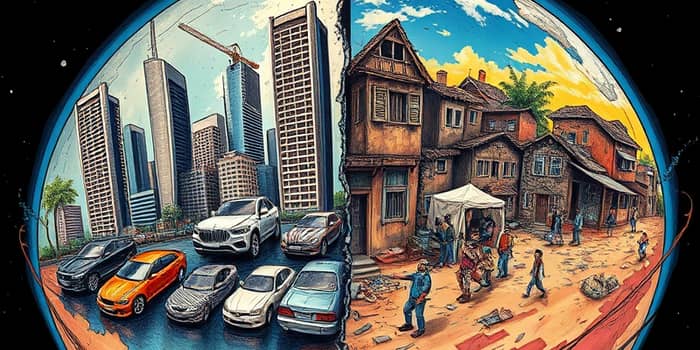
As the world emerges from the shocks of the pandemic and economic turmoil, the promise of an equitable rebound remains elusive. Instead of converging toward shared prosperity, nations and individuals are experiencing divergent outcomes that threaten social cohesion and long-term stability. In this article, we explore the data and drivers behind this growing divide and consider the policy choices that could shape a fairer future.
While some advanced economies quickly restored pre-pandemic growth rates, many low- and middle-income countries continue to struggle. Growth rates have slowed or stagnated in regions hardest hit by supply chain disruptions, high debt burdens, and limited fiscal space. In contrast, wealthier nations leveraged massive stimulus packages to prop up incomes and stabilize financial markets.
According to recent estimates, about 65% of the global population now lives in countries where income inequality is rising. This reflects uneven policy responses and structural factors that amplify gains for capital owners and skilled workers. As a result, the recovery narrative is splitting into two stories: one of robust expansion in select economies and another of fragile, uneven progress elsewhere.
Technological innovation has reshaped labor markets and wealth distribution. While digital platforms and automation boost productivity, they disproportionately reward those with advanced skills and access to capital. Tech founders and investors have seen soaring valuations, whereas many frontline and informal workers face stagnant wages.
As cities expand, the contrasts become more visible. Downtown districts boast luxury condominiums and corporate HQs, while informal settlements sprawl on their perimeters. This urban divide fuels visible tension and highlights the need for policies that ensure inclusive growth.
Income inequality differs dramatically across regions. In Sub-Saharan Africa, South Africa’s Gini of 63% underscores extreme wealth concentration, whereas European nations like Slovakia record levels below 25%. These contrasts reveal both historical legacies and recent policy choices.
Beyond national averages, the share of income accruing to the richest 10% remains disproportionately high. In Latin America, these top earners capture 55% of national income, compared to 36% in much of Europe. Such persistent regional imbalances undermine cohesion and fuel migration pressures as people seek better opportunities.
Rising inequality correlates strongly with declining trust in institutions. Surveys reveal that over half of the world’s population expresses little or no trust in their governments, and younger generations are even more skeptical. This erosion of faith undermines public support for collective action and reforms.
When citizens question the fairness of taxation, social spending, and regulatory oversight, polarization deepens. Misinformation campaigns and political gridlock often follow, making it harder to enact the bold, systemic reforms needed to address such disparities. Without a shared sense of purpose, societies risk fracturing along economic and ideological lines.
Reversing these trends requires coordinated action at global, national, and local levels. The United Nations’ Sustainable Development Goal 10 calls for reduced inequalities, emphasizing equity, security, and solidarity. Policymakers have proposed a range of measures to curb concentration of wealth and expand economic opportunity.
Such interventions can be mutually reinforcing. For example, revenue raised through wealth taxes can fund universal healthcare and quality schooling, reducing the risk that families slip into poverty after a health emergency or job loss.
As we chart the next decades, the choices we make today will determine whether recovery benefits all or deepens existing divides. Young people demand action on issues ranging from economic mobility to climate justice, and their voices are reshaping the policy debate.
By prioritizing intergenerational equity and sustainable growth, governments can foster resilience and strengthen social contracts. International cooperation remains essential: without multilateral efforts to address tax havens, regulate global finance, and support developing economies, national policies alone will fall short.
Ultimately, the challenge of widening inequality amid an uneven recovery calls for both moral clarity and pragmatic solutions. By embracing innovative policies, empowering marginalized groups, and rebuilding trust, we can transform this pivotal moment into an opportunity for a fairer, more inclusive world.
References













